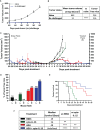Cyto-IL-15 synergizes with the STING agonist ADU-S100 to eliminate prostate tumors and confer durable immunity in mouse models
- PMID: 37465665
- PMCID: PMC10350564
- DOI: 10.3389/fimmu.2023.1196829
Cyto-IL-15 synergizes with the STING agonist ADU-S100 to eliminate prostate tumors and confer durable immunity in mouse models
Abstract
Introduction: Prostate cancer is one of the most commonly diagnosed malignancies in men with high mortality rates. Despite the recent therapeutic advances, such as immunotherapies, survival of patients with advance disease remains significantly low. Blockade of immune checkpoints has led to low response rates in these patients probably due to the immunosuppressive microenvironment and low mutation burden of prostate tumors. Combination of multiple immunotherapeutic regimes has also been unsatisfactory due to augmented adverse effects. To activate multiple immune-stimulatory pathways in the hostile prostate cancer microenvironment, we used a combination of cytotopically modified interleukin-15 (cyto-IL-15) with the stimulator of interferon genes (STING) agonist, ADU-S100.
Methods: To determine whether this combination regime could lead to both local and systemic anti-tumor effects, intratumoral administration of these agents was used in murine models of prostate cancer. Tumor growth and mouse survival were monitored, and ex vivo analyses, and RNA sequencing were performed on the tumors.
Results: Intratumorally injected ADU-S100 and cyto-IL-15 synergized to eliminate tumors in 58-67% of mice with unilateral tumors and promoted abscopal immunity in 50% of mice with bilateral tumors treated only at one side. Moreover, this combination regime offered immunoprotection against tumor rechallenge in 83% of cured mice. The efficacy of the combination treatment was associated with a strong innate and adaptive immune activation and induction of apoptotic and necrotic cell death. Cytokines, including type I and II interferons, and cytokine signalling pathways were activated, NK and T cell mediated cytotoxicity was increased, and B cells were activated both locally and systemically. While ADU-S100 led to an ulcerative pathology at the injection site, no other adverse effects were observed.
Discussion: Localised administration of a STING agonist together with cyto-IL-15 can confer significant systemic benefits and long-lasting immunity against prostate tumors while reducing immune related toxicities.
Keywords: IL-15; STING agonist; abscopal immunity; immunotherapy; prostate cancer.
Copyright © 2023 Papaevangelou, Esteves, Dasgupta and Galustian.
Conflict of interest statement
Authors CG, EP and PD are inventors in a patent application number WO2021058973A1 on lL-15 fusion peptides used to treat cancer. Authors CG, EP and PD are also inventors in a filed patent application number 2304385.4 on combination of cytotopically tailed IL-15 with a STING agonist. The remaining author declares that the research was conducted in the absence of any commercial or financial relationships that could be construed as a potential conflict of interest.
Figures






Similar articles
-
Combination of Interleukin-15 With a STING Agonist, ADU-S100 Analog: A Potential Immunotherapy for Prostate Cancer.Front Oncol. 2021 Mar 10;11:621550. doi: 10.3389/fonc.2021.621550. eCollection 2021. Front Oncol. 2021. PMID: 33777767 Free PMC article.
-
Blocking Tim-3 enhances the anti-tumor immunity of STING agonist ADU-S100 by unleashing CD4+ T cells through regulating type 2 conventional dendritic cells.Theranostics. 2023 Sep 4;13(14):4836-4857. doi: 10.7150/thno.86792. eCollection 2023. Theranostics. 2023. PMID: 37771774 Free PMC article.
-
Antagonism of regulatory ISGs enhances the anti-melanoma efficacy of STING agonists.Front Immunol. 2024 Jan 18;15:1334769. doi: 10.3389/fimmu.2024.1334769. eCollection 2024. Front Immunol. 2024. PMID: 38312842 Free PMC article.
-
Anti-cancer Therapies Employing IL-2 Cytokine Tumor Targeting: Contribution of Innate, Adaptive and Immunosuppressive Cells in the Anti-tumor Efficacy.Front Immunol. 2018 Dec 18;9:2905. doi: 10.3389/fimmu.2018.02905. eCollection 2018. Front Immunol. 2018. PMID: 30619269 Free PMC article. Review.
-
Intrinsic strategies for the evasion of cGAS-STING signaling-mediated immune surveillance in human cancer: How therapy can overcome them.Pharmacol Res. 2021 Apr;166:105514. doi: 10.1016/j.phrs.2021.105514. Epub 2021 Feb 23. Pharmacol Res. 2021. PMID: 33631336 Review.
Cited by
-
Molecular biology of the novel anticancer medications: a focus on kinases inhibitors, biologics and CAR T-cell therapy.Inflamm Res. 2025 Feb 17;74(1):41. doi: 10.1007/s00011-025-02008-5. Inflamm Res. 2025. PMID: 39960501 Review.
-
Targeting STING signaling for the optimal cancer immunotherapy.Front Immunol. 2024 Oct 9;15:1482738. doi: 10.3389/fimmu.2024.1482738. eCollection 2024. Front Immunol. 2024. PMID: 39450170 Free PMC article. Review.
-
Bibliometric and visual analysis of drug-specific immunotherapy from 1990 to 2024.Naunyn Schmiedebergs Arch Pharmacol. 2025 Mar 25. doi: 10.1007/s00210-025-04073-3. Online ahead of print. Naunyn Schmiedebergs Arch Pharmacol. 2025. PMID: 40131388
-
STING pathway as a cancer immunotherapy: Progress and challenges in activating anti-tumor immunity.Mol Biol Rep. 2024 Apr 5;51(1):487. doi: 10.1007/s11033-024-09418-4. Mol Biol Rep. 2024. PMID: 38578532 Review.
-
Unraveling the cGAS/STING signaling mechanism: impact on glycerolipid metabolism and diseases.Front Med (Lausanne). 2024 Nov 28;11:1512916. doi: 10.3389/fmed.2024.1512916. eCollection 2024. Front Med (Lausanne). 2024. PMID: 39669992 Free PMC article. Review.
References
Publication types
MeSH terms
Substances
LinkOut - more resources
Full Text Sources
Medical
Molecular Biology Databases
Research Materials

